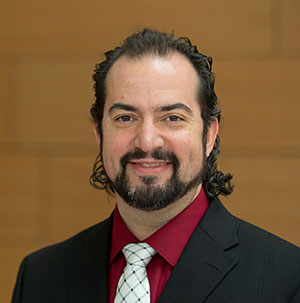Building University-Wide IT Accessibility
While many higher ed institutions focus mostly on Web accessibility or rely on a disability resources center to serve students in need, Temple University has ramped up its accessibility efforts across the board. Here's how.

Courtesy of Temple University
Temple University (PA) CIO Tim O'Rourke is the first to admit that in 2011 his organization didn't give technology accessibility enough consideration. "Our whole philosophy at the time was that if we have a disabled student, we have a really good disability resources center. Students can go there and they will handle it. That was our thought process," he said.
But just four years later, Philadelphia-based Temple has a university-wide Accessible Technology Initiative, with liaison positions in each college and department responsible for monitoring and reporting on Web and instructional-material accessibility. So how did Temple launch such a comprehensive initiative and maintain momentum?
Broadening the Scope
O'Rourke recalled that Sheri Stahler, associate vice president for client services and computer labs, had worked to convince him that accessibility was about to become a much bigger issue. Then in 2011, Pennsylvania State University and the National Federation of the Blind announced a major settlement agreement of a U.S. Department of Education, Office for Civil Rights complaint.
The PSU settlement did two things: "It told us that our philosophy of just sending people to the disability resources center was not enough," O'Rourke said. "It also gave us some guidelines on what to do, because we really didn't know what to do. The first thing we realized was that we had to do a complete audit."
O'Rourke realized launching a university-wide initiative would be difficult. "We are dealing with systems ranging from e-mail, Blackboard and classroom technologies to administrative and parking systems, and every system is different. What kind of program do you put in place to make it happen?"

Paul Paire, Temple U executive director of special projects: "When we looked at what happened at Penn State, it was obvious we couldn't just focus on the Web. We needed to address the institution as a whole. We needed a much broader scope."
Although he didn't have a budget to assign to the project, O'Rourke put Paul Paire, executive director of special projects, in charge of the accessibility initiative in early 2012. The external auditor's report told Paire that Temple was on par with other institutions that hadn't really addressed this issue, and the university needed to address gaps in learning spaces, labs, instructional materials and the Web. Some institutions focus mainly on Web accessibility, Paire noted. "But when we looked at what happened at Penn State, it was obvious we couldn't just focus on the Web. We needed to address the institution as a whole. We needed a much broader scope."
A Team Effort
Paire spoke to IT accessibility leaders at PSU and California State University about how to proceed. "They suggested team structures, work groups to create and who to include on teams, and the consultant who performed the audit also made suggestions," he said. O'Rourke reached out to faculty representatives and deans, the legal team, the provost, human resources and library executives, to find people willing to participate.
Work groups were created to help identify or create standards around procurement, instructional materials, Web sites and learning spaces. In some areas, standards already exist, Paire said, while in others there are not clear guidelines. For instructional materials, they looked at resources created at places such as Cal State and Stanford (CA).
"We looked at things such as accessible syllabus templates, and asked whether they make sense for us or are more rigorous than what can be done by faculty without significant assistance," he explained. "We really want faculty to be able to do this as part of their normal processes. We took lengthy documents and boiled them down to checklists, and then developed training seminars for how to make a syllabus accessible or how to make a PowerPoint accessible." Besides checklists, faculty members get a clear rationale for the process. "Then they tend not to see it as just arbitrary rules, because they get an explanation for why this is necessary," he said.
The purchasing department came on board quickly. Any piece of software or hardware purchased is checked for accessibility. "We ask the vendor for the VPAT [Voluntary Product Accessibility Template]," Paire said. "If it is not compliant, we ask people doing the purchasing to look at other products. In some niche areas — in science, for instance — there are no fully accessible products, so we created an exception process to handle that," Paire said.
An Accessible Technology Compliance Committee is tasked with effecting change and is responsible for setting standards, enforcement and granting exceptions.
Accessibility Liaisons
One early idea that came from an instructional materials work group was the creation of liaison positions in each college. "There is so much that we needed to address in the schools and colleges — computer labs, learning spaces, Web sites — every one of those aspects is handled by each college," Paire said. Without liaisons, central IT would have to do road shows and presentations to every single faculty member, he said. Creating liaison positions was seen as a way to get continuity and establish priorities. Every year the liaison for each college must write a progress report on accessibility and create a plan for making improvements.
"College deans appoint the liaisons based on knowledge, interest and ability to make it happen," said Barbara Dolhansky, associate vice president for computer services. "They must be respected within the college and have some level of authority and be committed to it."
Aaron Spector, director of disability resources and services and co-chair of the compliance committee, said the liaison positions are important because communication is key with this type of wide-ranging initiative. "There are policy statements and guidelines, but the ultimate goal is to change the culture at the university. So you need structures and channels for communication," he said, adding that the liaisons allow the compliance committee and working groups to get their work out to key people in each school and college.
Monitoring Compliance
O'Rourke noted that setting reasonable deadlines for compliance is important. "This is not going to happen overnight or even in a year," he said, "but we needed to put a plan together and attack things as we can, and we have done that."
Liaisons' annual reports touch on four areas: computer labs, course materials, learning spaces and Web sites. "We ask them to tell us how we communicated what the requirements are; how well they communicated that out to their college; and their progress," Paire said. Every school and college has made progress. There are resources issues, so some colleges are further along than others, he added. Some have launched brand-new Web sites, so they could bake accessibility in from the ground up. Others had to remediate theirs, which involved much larger projects.
As the deadline for Web site accessibility approached recently, a letter went out to all schools asking for updates on progress and a plan to reach compliance for those not yet at 100 percent. The letter said that if a plan was not submitted, the university might be forced to shut down the unit's Web site. "Rather than taking any Web site down right away, we are trying to work with them," Dolhansky said. "We will sit down with them and go over where they are not compliant and help them. That is our first step."
So why are universities with strong IT accessibility programs still the exception rather than the rule? "I think like at Temple previously, many universities view accessibility as the responsibility of a small disability resources unit," Spector said, "and that unit is usually not positioned to have a wide enough reach or authority to move large masses of people at the university. It is only when the CIO or a vice president takes ownership of this important compliance initiative that it can really move."
|
4 Tips for University-Wide Accessibility
Temple University's university-wide accessibility initiative is challenging but important work. Here are four best practices for getting there.
1) Read the Penn State University settlement agreement with the National Federation of the Blind. "It provides a guideline for where they need to be and describes the scope of the problem," explained Temple CIO Tim O'Rourke. Also, make sure someone in the legal counsel's office is involved, he added. Legal counsel for Temple worked to get up to speed with all relevant laws and has been instrumental to the process.
2) Recognize that accessibility is an ongoing process. "It is not something you can solve and then walk away from," said O'Rourke. "It is ongoing, because the technology is constantly changing, so you have to keep the awareness alive."
3) Begin with an audit to help set priorities; make improvements; and then evaluate again, recommended O'Rourke. Focus on communication capabilities: IT and disability services must figure out how to spread the message that accessibility is a shared responsibility, he added. They must promote resources and tools everyone can use to create IT access. "People want to do the right thing, but they have to be shown how."
4) Find a champion. According to Paul Paire, executive director of special projects, the greatest success factor at Temple was having the CIO be a strong leader on the effort. "If you want to launch an initiative on campus," he said, "get a leader who will back you up, lead by example and talk to peers, the deans of schools and colleges, to garner support."
|